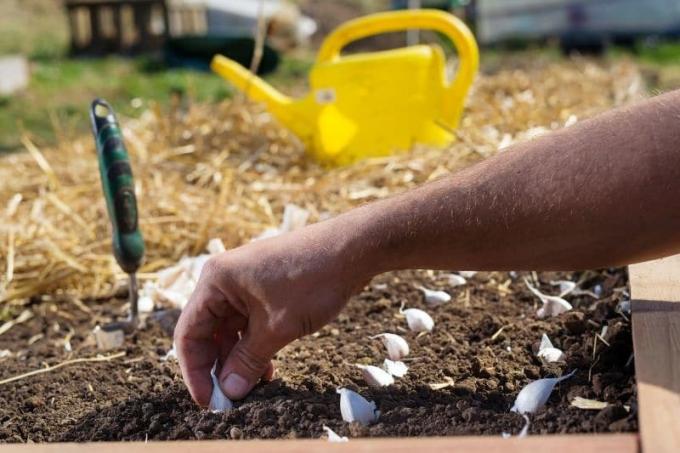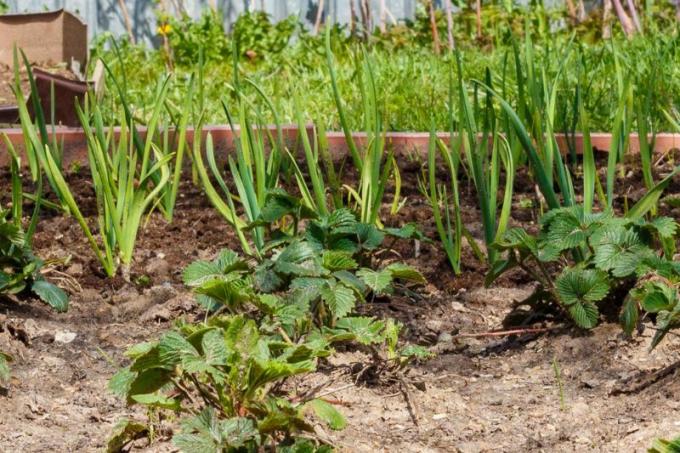
Garlic isn't for everyone, but it's very healthy. It is very easy to cultivate in the garden bed. You can also plant garlic in raised beds. Here are some growing tips.
In a nutshell
- best planting time September to October
- Work compost or rotting manure into the raised bed
- Planting depth 3 to 5 cm
- Apply a layer of mulch
- Avoid waterlogging
Table of Contents
- planting time
- Prepare raised bed
- planting distance
- Stuff the garlic properly
- Caring for garlic
- harvest
- Good plant neighbors
- frequently asked Questions
planting time
The ideal Planting time for garlic (Allium sativum). from September to October. Autumn planting has the advantage that the tubers will sprout until winter. You then have a big growth advantage until the next spring compared to garlic planted in the spring. Of course, planting in the spring is still possible. However, it should then take place between February and the end of March. This summer garlic has a shorter cultivation time and the crop yields can definitely be lower.
A notice: Garlic bulbs that have already been pushed out can shorten the growing season and reach maturity more quickly. To do this, the tubers are stored in a damp cloth in the refrigerator for a few days.
Prepare raised bed
Before you start sticking the tubers, you have to do this raised bed be properly prepared. Garlic is not very demanding. However, some requirements must be met for it to grow properly. Offer the leek
- a sunny location as well
- loose, humus- and nutrient-rich, well-drained soil

These measures on and in the raised bed also prepare it optimally for the tubers:
- remove weeds
- loosen the substrate
- either mix in 2 liters of compost per square meter
- Alternatively, thoroughly work in 2.5 kg of rotted manure per square meter
- preferably horse manure use
- if necessary, slightly moisten the substrate
A notice: Observe the crop rotation when growing vegetables. If possible, garlic should not be planted on areas where leeks (Allioideae) were already growing in the previous year.
planting distance
Garlic is also planted in rows in raised beds. Normally, the distances should be as follows:
- Row spacing 30 cm
- within the row 15 to 20 cm

When cultivating in raised beds, the area under cultivation is generally limited. You can therefore adjust the planting distances if necessary. by a fifth, i.e. the row spacing can also be only about 25 cm, for example.
Stuff the garlic properly
Once all the preparations are complete, the garlic can be planted in the raised bed. One thing first: Tubers from the supermarket should not be used, as they often come from warmer regions and do not cope so well with the local climate. In addition, only flawless toes without dried-up areas are inserted. To do this, the individual cloves are carefully separated from the tubers and the dry skin is removed. Further steps are:
- possibly tighten string for rows
- Lay out individual toes on the marked surface, observing the distances
- Make planting holes about 3 to 5 cm deep with a piece of wood
- Stick toes upright in planting hole
- i.e. the tip always points upwards
- Close the planting holes with soil and press down
- Don't forget to mark the rows
- then water well, avoiding waterlogging
The final step is the application of a mulch layer made of wood chips, straw or leaves. The layer should be about three to five centimeters high. In harsh winters, you can also cover the raised bed with a light covering of brushwood.

A notice: The rule of thumb when setting is: "Twice as deep as the toe is high." If in doubt, it is better to set the toes a little lower, as they pull towards the surface during budding.
Caring for garlic
If you don't want any spring onions, you should cut off the stem tips, because then all the energy can go into the development of the tuber. Otherwise, garlic is quite easy to care for. For optimal crop yields, you should
- loosen soil regularly and
- remove weeds
- only water on hot days
- But do not let the substrate dry out
- only fertilize a little
- possibly diluted once in May nettle manure give
harvest

The harvest time depends on the planting time:
- winter garlic planted in autumn from July
- summer garlic planted in spring from August to autumn
Harvest when the top third of the stalks has withered. Then the whole plant is carefully pulled out of the ground and allowed to dry off a bit. For storage, you can braid the wilted stems into pigtails and then hang them in a cool, airy, dark, and dry place.
Good plant neighbors
Garlic can too well grown in mixed culture will. Its smell repels pests like the onion fly and aphids. Diseases such as gray mold on strawberries can also be avoided. Examples of good neighbors are
- strawberries
- cucumbers
- potatoes
- Kohlrabi
- carrots
- Beetroot
- tomatoes

frequently asked Questions
Under no circumstances should garlic be placed in the immediate vicinity of other leek plants such as onions of all kinds, leeks or chives. They all belong to the same genus and usually have the same requirements for nutrients. So competition is often the result. In addition, these plants are all attacked by the same pests. In addition, garlic is not a good planting partner for all types of cabbage and legumes such as peas and beans.
Garlic is actually very robust. Its smell repels flies, spiders and lice. However, occasionally, although quite rarely, the onion fly can cause damage. The larvae then eat their way through the entire plant. The same applies to the caterpillars of the leek moth and larvae of the garlic fly. In addition, in rainy years or with persistent waterlogging in the root area, mold infestation can occur, which causes white rot. Affected plants should be removed.
Yes, it is possible, but it is rarely done. You either buy the seeds or harvest them yourself. You are in the flower of the plant. The seeds are very hard and purple in color. Sow in February or October in a sunny and sheltered place. Sow in rows, 10 to 15 cm apart and 1 to 2 cm deep. It is important that the seed is watered well.



